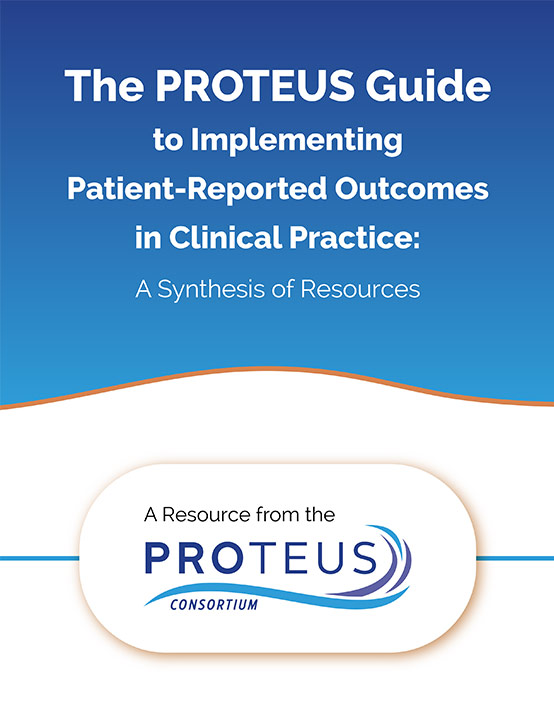PROTEUS — PRACTICE

Identifying Barriers and Facilitators: Chapter 2
In this excerpt (Chapter 2) from the PROTEUS-Practice Guide, you’ll learn about barriers and facilitators to effectively collecting, analyzing, interpreting, and integrating patient-reported outcomes (PRO) in clinical practice.
This webpage contains the entire contents of Chapter 2. You can also download the PROTEUS-Practice Guide by clicking here.
Key Points
- Barriers to the use of patient-reported outcomes (PROs) in clinical practice occur at the patient-, provider-, administrator-, and system-level
- While there may be similarities in the barriers experienced, the facilitators to alleviate these barriers may vary depending on the unique context of the healthcare setting
Overview
PRO data has tremendous potential benefit to patient care, but barriers in the collection, analysis, interpretation, and integration of this data can hinder its application in practice. PROs are often treated as a separate data set. The systems and workflow are different. While not insurmountable, the change management needed to support integration is important to address.
- At the patient level, common barriers include those related to accessibility of PRO systems, lack of patient buy-in to the use of PROs, lack of familiarity with electronic collection (if electronic collection used), literacy in the language of collection, and burdensome PRO collection processes.
- At the provider level, barriers include technological and logistical challenges, disruption to workflow, time and resource constraints, and uncertainty regarding how to integrate PRO data in clinical care.
- At the administrative level, barriers include cost, lack of shared values/purpose, uncertainty in how to assess the impact of PRO collection on quality, and legal/regulatory concerns.
- Finally, at the system level, barriers include (a sometimes limited) technical capacity and the fact that there is no “one-size-fits-all” approach for integrating PROs into practice.
In this section we explore the general barriers identified for using PROs in clinical care and highlight potential solutions or facilitators, where they exist, to help overcome these challenges.
Questions and Considerations
A. What are potential patient-level barriers and facilitators to the collection and use of PRO data in clinical care?
| BARRIERS | FACILITATORS | |
| Accessibility |
|
|
| Lack of buy-in |
|
|
| Burden reporting PROs |
|
|
B. What are potential clinician-level barriers and facilitators to the collection and use of PRO data in clinical care?
| BARRIERS | FACILITATORS | |
| Technologic and logistical challenges |
|
|
| Disruption to workflow |
|
|
| Time and resource constraints |
|
|
| Uncertainty with integrating data into clinical care |
|
see Chapter 9, Presenting Results, and Chapter 11, Responding to Issues |
C. What are administrative-level barriers and facilitators to the collection and use of PRO data in clinical care?
| BARRIERS | FACILITATORS | |
| Cost |
|
|
| Lack of shared values/purpose |
|
|
| Uncertainty in how to assess the impact of PRO collection on quality |
|
|
| Legal/regulatory concerns |
|
|
D. What are system-level barriers and facilitators to the collection and use of PRO data in clinical care?
| BARRIERS | FACILITATORS | |
| No “one-size-fits-all” approach |
|
|
| Technical capacity |
|
|
| Lack of in-house expertise |
|
|
Relevant Primary Resources
The information presented here is an overview of barriers and facilitators. For more detailed information please see the following sources:
Background And Citing The Proteus-Practice Guide
Nothing in this Guide should be construed to represent or warrant that persons using this Guide have complied with all applicable laws and regulations. All individuals and organizations using this template have the responsibility for complying with the applicable laws and regulations or regulatory requirements for the relevant jurisdiction.
Each chapter of the Guide lists the key foundational resources that informed its content. To appropriately recognize the foundational resources, we encourage you to cite both the Guide and the relevant foundational resource(s). Recommended citations are provided here.
Suggested Citation
The PROTEUS Guide to Implementing Patient-reported Outcomes in Clinical Practice
A synthesis of resources. Prepared by Crossnohere N, Brundage M, Snyder C, and the Advisory Group, 2023. Available at: TheProteusConsortium.org.
Further Reading
The Guide draws primarily from the foundational resources cited in each chapter. Please click here to find a selection of other relevant references.

